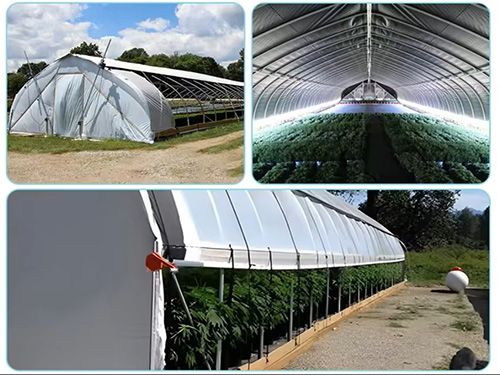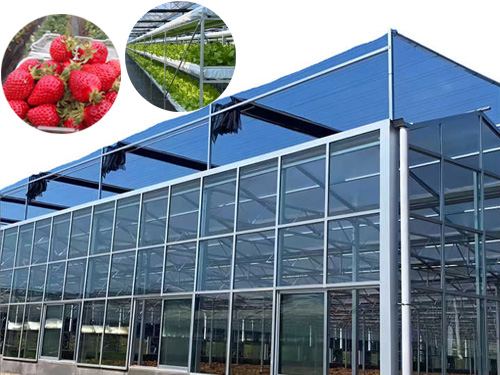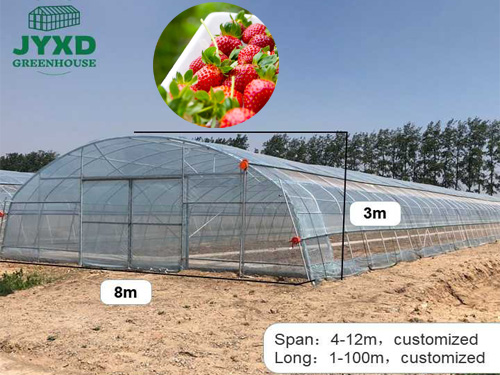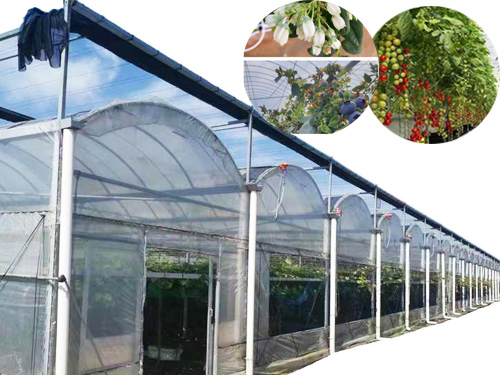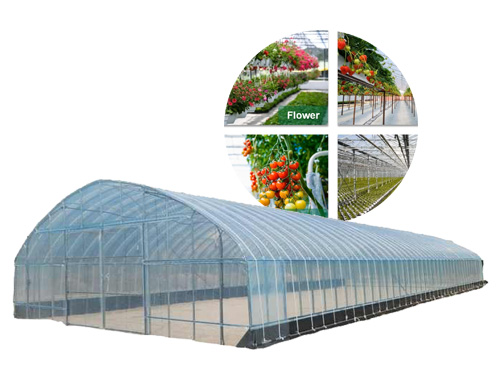NEWS DETAILS
NEWS INFORMATION
Integration and Applications of Smart Greenhouse Control Systems
AUTHOR:jyxd-greenhouse DATE:2025-01-17 15:40:57 HITS:118
As the demand for sustainable and efficient agricultural practices grows, the integration of smart greenhouse control systems has become a game-changer in modern farming. These systems combine advanced technologies like sensors, automation, and data analytics to create optimal growing environments for plants while reducing resource consumption. In this article, we will explore the various applications of smart greenhouse control systems and how their integration can enhance greenhouse management, improve crop yields, and reduce operational costs.
What Are Smart Greenhouse Control Systems?
Smart greenhouse control systems are sophisticated setups that use technology to monitor and control the environmental factors inside a greenhouse, such as temperature, humidity, light, CO2 levels, and soil moisture. These systems rely on sensors to gather real-time data and use this information to automatically adjust climate controls, irrigation systems, and other factors that influence plant growth. Through automation and data-driven decision-making, these systems help maintain optimal conditions for plants, leading to improved crop health and increased productivity.
Key Components of Smart Greenhouse Control Systems
To understand the effectiveness of smart greenhouse control systems, it’s essential to look at the key components that make these systems work:
1. Environmental Sensors
Sensors play a critical role in smart greenhouse systems. They monitor various environmental parameters such as:
· Temperature Sensors: Measure the ambient temperature inside the greenhouse, ensuring that plants are exposed to ideal growing conditions.
· Humidity Sensors: Monitor moisture levels in the air, which is vital for controlling humidity and preventing the growth of mold or mildew.
· Light Sensors: Measure light intensity to ensure plants receive the appropriate amount of light, optimizing photosynthesis.
· Soil Moisture Sensors: Determine the water content in the soil, helping to automate irrigation systems and avoid over- or under-watering.
These sensors provide real-time data that is used to adjust environmental conditions to ensure the greenhouse climate stays within optimal parameters for plant growth.
2. Automation Systems
Automation is at the heart of smart greenhouse control systems. These systems can adjust various greenhouse components automatically based on sensor data, reducing the need for manual intervention. Examples of automated systems include:
· Climate Control: Automated temperature and humidity control systems adjust heating, cooling, and ventilation to maintain ideal conditions for crops.
· Irrigation Systems: Automated watering systems ensure that plants receive the correct amount of water based on soil moisture data, reducing water waste and preventing over-irrigation.
· Lighting Systems: Automated lighting controls can adjust artificial lighting levels depending on the available natural sunlight, ensuring that plants receive consistent light exposure.
By automating these systems, greenhouse operators can maintain a more consistent environment, reduce labor costs, and increase efficiency.
3. Data Analytics and Cloud-Based Platforms
Smart greenhouse systems typically integrate with cloud-based platforms that collect and analyze data from various sensors. These platforms provide greenhouse operators with insights into the overall health of crops, environmental conditions, and resource usage. The data analytics capabilities of these platforms help in:
· Predictive Analysis: Forecasting future environmental conditions and plant growth patterns based on historical data.
· Real-Time Monitoring: Allowing operators to monitor greenhouse conditions remotely, providing a more flexible and efficient management approach.
· Optimization: Identifying trends and patterns to optimize resource usage, such as water, energy, and fertilizers, leading to cost savings.
Cloud-based platforms also allow for easy access to data, making it simpler for greenhouse managers to make informed decisions.
Applications of Smart Greenhouse Control Systems
The integration of smart control systems in greenhouses has revolutionized modern agriculture, offering several key applications that improve operational efficiency, sustainability, and crop yields.
1. Energy Efficiency and Resource Conservation
One of the main benefits of smart greenhouse systems is their ability to optimize the use of resources such as water, energy, and fertilizers. Through the use of sensors and automated systems, smart greenhouses can minimize waste and reduce consumption:
· Water Conservation: Automated irrigation systems ensure that plants receive the exact amount of water needed based on soil moisture data, reducing water waste and conserving resources.
· Energy Savings: Smart climate control systems regulate heating, cooling, and ventilation based on real-time data, reducing the energy required to maintain the ideal growing environment.
· Fertilizer Efficiency: Fertilizer application can be optimized through automated systems that adjust the amount based on plant needs, reducing excess use and environmental impact.
By integrating these technologies, greenhouses can reduce operational costs while maintaining sustainable practices.
2. Improved Crop Yields and Quality
Smart greenhouse control systems help create an environment that maximizes plant growth, leading to higher crop yields and better-quality produce. The automation and precision provided by these systems result in:
· Uniform Growth: By maintaining optimal temperature, humidity, and light conditions, plants grow uniformly, leading to consistent quality and yields.
· Faster Growth Rates: The ability to adjust environmental conditions based on real-time data allows plants to grow faster, resulting in shorter crop cycles and increased harvest frequency.
· Disease Prevention: Climate control and environmental monitoring help prevent the onset of diseases by reducing stress factors, such as temperature fluctuations and excessive humidity, which can create conditions for pathogens to thrive.
The combination of these factors results in healthier plants and higher productivity.
3. Remote Monitoring and Management
With cloud-based platforms and mobile apps, greenhouse operators can remotely monitor and control their greenhouses from anywhere. This feature offers several benefits:
· 24/7 Monitoring: Operators can continuously monitor greenhouse conditions, even outside of regular working hours, to ensure everything is functioning correctly.
· Data-Driven Decision Making: Real-time data allows operators to make quick adjustments to temperature, humidity, or irrigation, ensuring that plants are always in the best possible environment.
· Alerts and Notifications: If there is a sudden change in environmental conditions, operators can receive alerts on their mobile devices, enabling immediate action to prevent potential crop damage.
Remote monitoring reduces the need for constant physical presence in the greenhouse, saving time and labor costs.
4. Precision Agriculture and Sustainability
Smart greenhouse control systems are key to advancing precision agriculture, which focuses on using technology to optimize farming practices. By integrating data and automation, these systems support sustainable farming practices by:
· Reducing Resource Waste: Automated systems ensure that resources are used only when necessary, leading to reduced waste and lower environmental impact.
· Increasing Crop Efficiency: By maintaining ideal growing conditions, plants can achieve their full potential, increasing productivity without expanding land use.
· Supporting Organic Practices: Smart systems can help maintain optimal growing conditions for organic crops, reducing the need for chemical interventions and promoting environmentally friendly farming practices.
Sustainability is at the core of smart greenhouse technology, making it an essential tool for the future of agriculture.
Conclusion
The integration of smart greenhouse control systems offers a wide range of benefits, including energy efficiency, improved crop yields, resource conservation, and sustainability. By utilizing sensors, automation, and data analytics, greenhouse operators can create an optimal growing environment that maximizes plant health while minimizing resource usage and operational costs. As the demand for sustainable agriculture continues to grow, smart greenhouse control systems will play an increasingly important role in the future of farming, helping to meet global food demands while protecting the environment.
Hebei Juyou Xinda Greenhouse Facilities Co.,Ltd.
Copyright © 2024-2025 https://www.jyxd-greenhouse.com. All Rights Reserved Hebei Juyou Xinda Greenhouse Facilities Co.,Ltd.Copyright





 Current Location:
Current Location:


